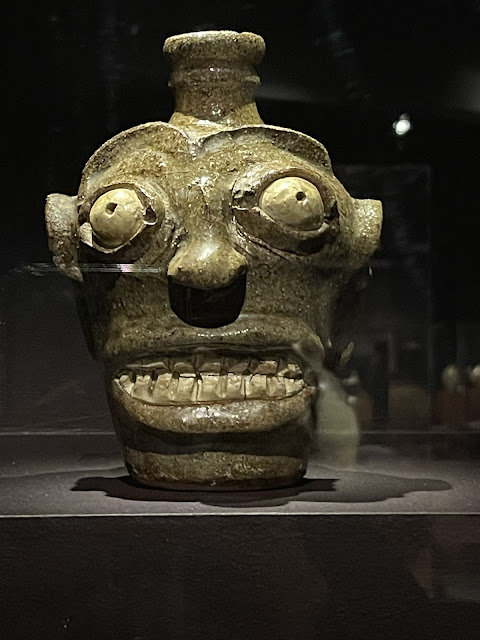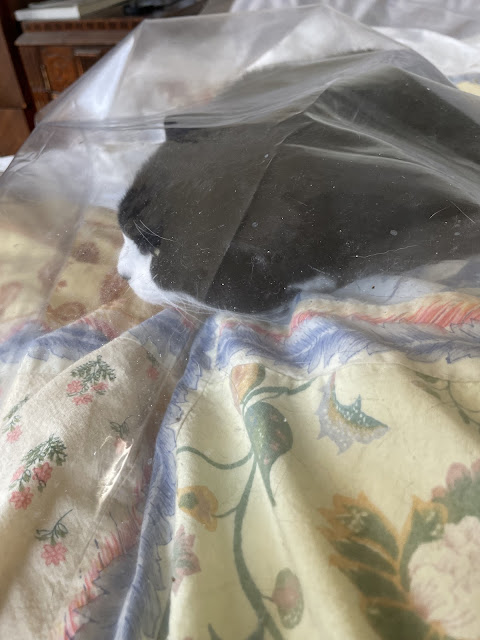Day 192, September 24, 2020
The Perfect Slice
Today's soundtrack: Stevie Ray Vaughn at The American Caravan with Lonnie Mack, 1986
and Robert Cray Live in Concert 2008
When I was a little Papa Gino's was our pizza place of choice. We didn't really have the knowledge that pizza could be better, it was what we knew. My father would take us to the one on Route 9 in Framingham, and we'd sit in the franchise's signature awninged building and while away the time as we waited for the pizza to come out of the oven. I don't remember my mother ever eating pizza, it seemed like something my father indulged in with us. He has an appreciation for such things, and even now expresses a longing fondness for Friendly's upon occasion.
 |
| My dad found the Jolly Boat! |
We always had some some variation of the supreme, a marvelous testament to excess with two or three different meats, and a gentle nod to the vegetables with green peppers, maybe some mushrooms and onions. The whole thing was a greasy extravagance that fed a whole generation of teen acne.
This was far from the advent of wood fired brick pizza ovens, at least where we lived. Occasionally we ventured into the small independent pizzerias, but we didn't have a refined pizza palette yet. The independent pizzerias were prized for baklava, or a particularly nice Greek salad, but we didn't really know when we had stumbled onto something special. At least, I didn't as a kid. Pizza was a great geographic equalizer, in almost any town one visited, you could find a comforting pepperoni slice. But coming home always meant Papa Gino's.
It is funny to think that is no longer the case. Pizza has become something bespoke and distinct. Just in our area there is Antonio's, Bread Euphoria, Hungry Ghost, Hillside, HighBrow, Magpie and countless others, each distinct and unique in flavor, texture, and presentation. I can't remember the last time I saw a Papa Gino's, let alone a Bertucci's. Tonight, I made a flatbread pear pizza, with almonds, blue cheese, mozzarella, arugula, and balsamic vinegar. How strange that would have seemed when I was a kid, like when I saw my best friend take little straw-fulls of Coke and dribble it over his slice so he didn't burn his mouth. I couldn't imagine such a violation. I would not even try it, it seemed so much an anathema to the concept of pizza.
I am sure I would have turned my nose up at the thought of a sauceless, pizza. A pizza with fruit on it. A pizza with salad on top. And yet, in this modern world, we have become acclimated to have all kinds of marvelous variety, with as much variation in the crust as what might be offered as toppings.
Of course, there is still the every elusive quintessential New York slice. I'm not exactly sure what might qualify as the quintessential slice, but I'm pretty sure it is not the slice you can get downstairs at Grand Central Station. But, I'm not sure the quintessential New York slice exists anymore. It is a figment of memory, a dream about what a good slice could be. The larger than paper plate triangle with no more than marinara and cheese. I think it is possible that the perfect slice can only be experienced at a certain age, after the just-right proportions of evening activities are consumed, and it is probably accompanied by the smell of the subway mixing with the exhaust of yellow taxis.
Sometimes, it feels like the good times are like that elusive slice... something so distant one can almost taste it when you close your eyes. Memory sometimes becomes more visceral and vibrant than the absence. The pursuit to recapture that feeling of breathing easy, when life feels like standing on a corner with a slice in hand, and everything is the right temperature, and even a napkin is entirely unnecessary, that pursuit can feed us too, sometimes.
Take care,
Leo
From Our Friends:
From the It Gets Better Project:
It Gets Better Canada: Why We Need Bisexuality Day
It Gets Better Canada celebrates Bisexuality Day and disputes some of the most common misconceptions associated with bisexuality.
From the UMass Arts Extension Service:
Did you know that Creative Women Leading Climate Action (CWLCA), a virtual symposium and public event series highlighting artists and arts professionals creatively responding to climate change, is kicking off next week? Register for this phenomenal series of workshops, panels, and events before it is too late! Now is the time to learn, share, and discover ways to get involved to make a more livable world for ourselves and future generations. Get inspired by leaders, thinkers, and makers who are on the front lines of creating change! |
From Academic Impressions:
Developing Intentional Strategies to Improve Campus Climate: A Discussion Space Share ideas and get expert guidance on how to create a culture of equity and inclusion on your campus. The webcast is presented by the authors of Fix Your Climate: A Practical Guide to Reducing Microaggressions, Microbullying, and Bullying in the Academic Workplace. Sign up today. |
From the Smith College Jandon Center:
| See Full Jandon BLM Activism Campaign Here |
From Korn Ferry:
From Teaching Tolerance:
Sounds Like Hate—a new podcast from our colleagues in the Southern Poverty Law Center’s Intelligence Project—is about the dangers and peril of everyday people who engage in extremism, and the ways to disengage them from a life of hatred.
The podcast dedicates two episodes to exploring how one Vermont high school is grappling with questions about flying a Black Lives Matter flag and removing a mascot some say bears a disturbing resemblance to a hooded Klansman.
Find more information about how this school confronted racism and listen to the podcast here.
From the UMass Fine Arts Center:
Bodies at Risk: Black Violin
Friday, October 2, 7 p.m. ET
Live Virtual Performance with post-show Q&A
Black Violin is led by classically trained string players Wil B. (viola) and Kev Marcus (violin). The band uses their unique blend of classical and hip-hop music, often described as “classical boom," to overcome stereotypes and encourage people of all ages, races, and economic backgrounds to join together to break down cultural barriers. As part of their engagement, Wil and Kev offer a special live virtual concert followed by a post-show conversation on the state of Black music and art in the U.S. today moderated by African American studies scholar Stephanie Shonekan. Free tickets are encouraged so you don't miss this one-time live presentation. You may also submit questions in advance throgh the check out process.

Bodies at Risk is a series of creative conversations between BIPOC performing artists, educators, activists, and other experts working to shift American society’s understanding of the racialized body and social justice. These events aim to engage, move, and surprise audiences through artistic demonstration and intellectual curiosity. Artist and audience chat included & encouraged.
Today's Online Teaching Tips:
From the It Gets Better Project:
The More You Know: It Gets Better EDU
Explore our wide selection of LGBTQ+ inclusive EduGuides and bring some diversity into your classroom, your home and your digital learning space.
From Higher Ed Jobs:
How to Cultivate Civil Discourse on Campus in Times of Crisis and Unrest
by Heide Winston and Scott Cowen 
Despite efforts to cultivate free and civil speech on campus, the trend to inhibit diversity of thought continues to be a challenge for higher education and, by extension, our democracy. At the same time, the question about how we can promote equality on campus in a climate that protects freedom of speech remains. Scott Cowen and Heide Winston explore these contradicting concepts and provide some insight on how to achieve both.
From the Chronicle of Higher Education:
What Students Want
In recent months there’s been no shortage of surveys in which students describe the challenges they faced during the pivot to remote education in the spring and summer. Many struggled to secure consistent Wi-Fi access and a quiet place to learn. They felt overwhelmed, not just by the pandemic, but in trying to keep track of assignments, deadlines, and communication with their professors. They missed the routines and relationships of campus life. Motivation was a real challenge.




Comments
Post a Comment